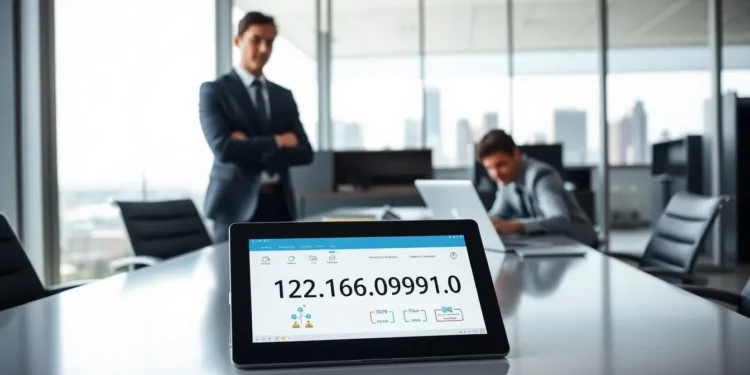Ever stared at a series of numbers like 192.168.0991.00 and thought, “What on earth does this even mean?” Don’t worry: you’re not alone. Many people find IP addresses to be more baffling than their Wi-Fi connection dropping out right before a Zoom meeting. This guide is here to unravel that tangled web, so whether you’re just trying to connect your printer or diving deeper into networking, you’ll walk away with the insights you need. Get ready to sound like a pro and maybe even amuse your friends with your newfound knowledge.
192.168.0991.00

An IP address, or Internet Protocol address, is the unique identifier assigned to each device connected to a network. Think of it as your device’s home address in the vast neighborhood of the internet. When you send data online, like an email or a funny cat meme, the data gets funneled through these addresses. Without them, information would run around like a chicken without a head, unsure of where to go.
Every device needs one to communicate effectively, just like you need an address to order pizza. If every pizza place didn’t know where to deliver, you’d be in trouble. An IP address allows your router and devices to ensure they’re pointing to the right location.
Types of IP Addresses
There are two main types of IP addresses to know: IPv4 and IPv6.
IPv4 addresses are made up of four sets of numbers ranging from 0 to 255, separated by periods, like 192.168.1.1. They account for most IP addresses in use today. But, with the increasing number of devices on the internet, IPv4 is slowly running out of unique addresses, similar to how parking spots fill up at a concert.
That’s where IPv6 comes in. This new version uses hexadecimal values and can support a whopping 340 undecillion addresses. This is the equivalent of having enough parking spots for every living creature, and their imaginary friends, in the universe.
So, while IPv4 is like a bustling city, IPv6 represents an entire universe of possibilities.
IPv4 vs. IPv6
The difference between IPv4 and IPv6 is not just a matter of number crunching. It also enhances security and efficiency. IPv4 is known for simple and familiar setups and can be easily understood by most users. But, it lacks the scalability needed for the ever-expanding internet landscape.
IPv6, on the other hand, brings a slew of benefits. Apart from its massive address space, it includes better security features such as mandatory IPsec support. Think of it like switching from a locked door to a bank vault, way more secure. Also, IPv6 reduces overhead and improves routing efficiency.
So, while IPv4 moves along steadily, IPv6 is the modern marvel that keeps the digital world spinning.
Decoding the Format: Understanding 192.168.0991.00
Now onto the enigmatic sequence 192.168.0991.00. Unlike its more straightforward counterparts, this address raises some eyebrows. The second segment, 0991, doesn’t follow the conventional numbering system used in both IPv4 and IPv6. Remember, each segment in a standard IPv4 address should contain numbers between 0 and 255.
So, 0991 exceeds this limit, leaving it in an IP address purgatory, unusable. When encountering something like 192.168.0991.00, it’s essential to analyze each segment. You could visualize it as a not-so-quirky puzzle piece that doesn’t quite fit anywhere. Resolving issues with such an address often involves adjusting the numbers to fall within the valid range.
Common Issues with IP Address Formats
IP address formats can trip up even the seasoned networker. Here are some frequent culprits:
- Segment Overflow: Each part of an IPv4 address must remain between 0 and 255. Anything above or below throws a wrench in the works.
- Incorrect Formatting: A stray period or an extra digit can create chaos. It’s akin to adding peanut butter to your jelly sandwich instead of creamy or chunky, you end up with a mishmash.
- Network Conflict: Two devices fighting for the same address can lead to a stalemate. This requires addressing the conflict promptly to keep everything efficient.
- Outdated Addressing: Using a legacy device may limit compatibility with new networks. It’s essential to stay updated.
How to Troubleshoot IP Address Problems
When IP address problems arise, it can feel like facing an exam with no preparation. But fear not. Here’s how to tackle common issues:
- Verify the Format: Check each segment of the address. Are they within range? A brief glance can save hours of headaches.
- Check Device Settings: If your device shows a mysterious IP, make sure the settings point to the correct subnet.
- Restart Your Device: Sometimes a simple reboot can refresh the network settings and resolve connection hitches.
- Flush the DNS Cache: If your connection is stubborn, clearing the DNS cache might do the trick. Think of it as clearing your browser history to speed things up.
- Connect to the Router: If all else fails, connect directly to your router with an Ethernet cable, ensuring a stable path.
Best Practices for Managing IP Addresses
Managing IP addresses can help streamline your network, making it as smooth as a well-oiled machine. Here are some best practices:
- Use Static IPs for Critical Devices: Assigning static IPs to routers and printers can help eliminate connectivity issues. Think of it as putting their addresses on a map.
- Use DHCP: This works like a dynamic assistant, automatically assigning IP addresses to devices as they connect to the network.
- Document Your Setup: Maintaining a clear record of assigned IPs helps prevent conflicts and confusion.
- Segment Your Network: Dividing your network into subnets can improve efficiency and security. This method’s similar to organizing a messy closet, everything finds its place.
By following these guidelines, the management of IP addresses becomes a breeze.















